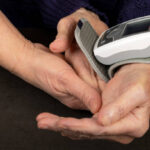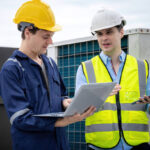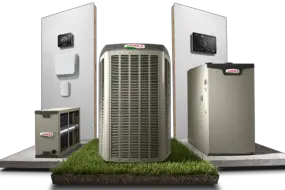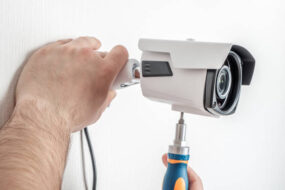Fall detection devices:
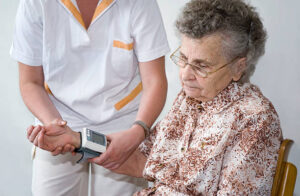
Imagine this: you get a call from your elderly parent, their voice shaky with panic. They’ve fallen, and they’re unable to get up. It’s a frightening scenario, and unfortunately, one that happens all too often. According to the Centres for Disease Control and Prevention (CDC), one in four adults aged 65 and over falls annually.
In today’s ageing society, ensuring the safety and well-being of seniors is a top priority. A fall detection device is an innovative solution to this challenge. Designed to detect falls and alert carers or emergency services automatically, these devices offer additional protection for seniors living alone or with mobility issues.
These falls can have serious consequences, leading to broken bones, head injuries, and even a fear of falling, which can limit mobility and independence. But there’s positive news! Fall detection devices are becoming increasingly popular tools for helping seniors stay safe and live independently for longer.
In this comprehensive guide, we will explore how fall detection devices work, their benefits, applications, and the challenges they face. By the end of this article, you’ll have a thorough understanding of these life-saving devices and how they can enhance the safety of your elderly loved ones.
What are fall detection devices?
Fall detection devices are specialised tools equipped with sensors and algorithms designed to detect sudden movements or changes in position that indicate a fall. They come in various forms, including wearable devices like smartwatches, pendants, and even integrated systems in smart home setups. These devices are essential for providing timely assistance and reducing the risk of complications from falls, such as fractures or prolonged periods of immobility.
Read more: How Do I Connect My Tuya Smart Device to the Network?
How do fall detection devices work?

Fall detection devices are like tiny superheroes, constantly monitoring your loved one’s movements. They typically come in two forms: wearables like pendants or bracelets and in-home devices that use sensors to detect falls. Let’s explore the key components of this powerful technology:
1. Accelerometers are the secret weapon.
The accelerometer is the heart of fall detection technology. This little sensor is like a built-in tilt-a-whirl, constantly measuring changes in speed and direction. When a fall occurs, there’s a sudden and dramatic shift in movement. The accelerometer picks this up and sends a signal to the device’s processor.
2. Smart Algorithms: Separating Falls from False Alarms
However, not every bump or bend is a fall. That’s where smart algorithms come in. These programmes analyse the data from the accelerometer, looking for specific patterns that indicate a fall. This could include a sudden drop, a period of no movement after the fall, or a specific angle of impact.
3. Alert Mechanisms
Once a fall is detected, the device activates an alert mechanism. This can include:
i. Audible Alarms: To notify nearby individuals.
ii. Text messages: sent to predefined contacts.
iii. Automated calls are made to emergency services or carers.
iv. Mobile app notifications provide real-time monitoring.
These alerts ensure that help is dispatched quickly, reducing the time a senior may spend unattended after a fall.
Types of Sensors Used for Fall Detection Devices
i. Accelerometers: Measure the rate at which velocity changes.
ii. Gyroscopes: Detect rotational movement.
iii. Barometers: To detect height changes, measure atmospheric pressure.
iv. Proximity Sensors: Determine if the user is close to the ground.
Read more: How Lennox S40 Thermostats Can Benefit Smart Homes
Beyond the Accelerometer: Exploring Fall Detection Devices’ Additional Features
Fall detection devices aren’t one-trick ponies. Many offer additional features that enhance safety and independence.
i. GPS Tracking: Some devices come with GPS functionality, allowing emergency personnel to locate the senior quickly and easily, especially if they’re outdoors when a fall occurs.
ii. Fall Impact Sensors: These sensors go beyond simple movement detection. They can distinguish between a harmless bump and a significant fall, reducing false alarms.
iii. The Manual Help Button: Falls aren’t the only emergencies. Many devices come with a manual help button that seniors can press to summon assistance in any situation.
iv. Water Resistance: For added peace of mind, some devices are water-resistant, allowing seniors to wear them in the shower or bath without worry.
Taking Action: Sending Help When Needed
If the algorithm determines a fall has likely happened, the device will spring into action. Here are some common responses:
i. Automated Alerts: The device may send an automated alert to a monitoring centre. These professionals will then attempt to contact the senior and assess the situation. If there’s no response, they can dispatch emergency services or notify designated contacts.
ii. Two-Way Communication: Some devices have built-in speakers and microphones, allowing for two-way communication. This means seniors can talk directly with the monitoring centre, even if they’re unable to get up.
iii. Manual Help Buttons: Many devices also include a manual alert button that seniors can press if they need help, even if they haven’t fallen.
Read more: Unveiling the Top Security Cameras for 24/7 Recording
Benefits of Fall Detection Devices

Fall detection devices offer a range of benefits for both seniors and their loved ones:
i. Immediate assistance
The primary benefit of fall detection devices is the immediate assistance they provide. These devices can significantly reduce response time by quickly alerting carers or emergency services, which is critical for preventing further injury or complications.
ii. Families can have peace of mind.
Families gain peace of mind knowing their loved ones are monitored and that help is just a call away. This can be particularly comforting for those who live far from their elderly relatives or cannot provide constant supervision.
iii. Increased independence for seniors
Seniors can maintain a higher degree of independence, knowing they have a safety net in case of a fall. This can improve their quality of life, allowing them to continue living in their own homes for longer.
iv. Avoiding complications
Quick response times can prevent complications such as hypothermia, dehydration, or pressure ulcers, which can occur if a senior is left unattended for an extended period after a fall.
Applications of Fall Detection Devices
i. Home Use
Fall detection devices are ideal for home use, providing continuous monitoring without being intrusive. They can be integrated with smart home systems for added convenience, such as automated lighting and door locks.
ii. Healthcare Facilities
In healthcare settings, fall detection devices are used to monitor patients, particularly those with high fall risk due to conditions like dementia, Parkinson’s disease, or post-surgery recovery.
iii. Outdoor activities
Some advanced fall detection devices are designed for outdoor use, featuring GPS tracking to locate the user quickly. This is beneficial for active seniors who enjoy outdoor activities like walking or gardening.
iv. Rehabilitation Centres
In rehabilitation centres, fall detection devices can monitor patients during physical therapy sessions, ensuring safety and providing data on their progress and movement patterns.
Applications Beyond the Home: Where Fall Detection Devices Shine
Fall detection devices aren’t just for home use. They can be incredibly beneficial in various situations.
i. Seniors living alone: These devices provide an extra layer of security for seniors who don’t have immediate help readily available.
ii. Seniors with mobility issues: Those who are at a higher risk of falling due to balance problems or weakness can benefit from the safety net a fall detection device offers.
iii. Seniors recovering from surgery or illness: During recovery periods, when balance and coordination might be compromised, fall detection devices can provide valuable support.
How to Choose the Right Fall Detection Device for Your Needs

With an array of fall detection devices available, choosing the right one depends on your specific needs. Here are some considerations:
i. Lifestyle: Is the senior active or more sedentary? A wearable device might be suitable for an active senior, while an in-home system could be better for someone who spends most of their time indoors.
ii. Medical Conditions: Do the seniors have any medical conditions that necessitate specific monitoring features?
iii. Budget: The cost of fall detection devices varies. Consider features, monitoring services, and long-term costs.
iv. Wearable vs. In-Home Devices: Wearables are comfortable and discreet, but they may not have a signal everywhere. In-home devices offer wider coverage but require strategic sensor placement.
v. Medical Alert Integration: Some fall detection systems integrate with traditional medical alert systems, offering additional features like two-way communication and medication reminders.
vi. Fall Detection Accuracy: Look for devices with advanced algorithms that minimise false alarms.
vii. Battery Life: Consider how long the device’s battery lasts between charges.
viii. Ease of Use: The device should be user-friendly for your loved one, with clear instructions and simple controls.
Read more: How Do Red and Blue Lighting Security Cameras Work?
Challenges and limitations of fall detection devices
i. False Alarms
False alarms are one of the biggest challenges with fall detection devices. A sudden movement, such as stooping or dropping the phone, can trigger them. Frequent false alarms can lead to alarm fatigue, in which users or carers become desensitised to alerts.
ii. Device wearability
For continuous monitoring, the device’s comfort and usability are crucial. Some seniors may find wearable devices uncomfortable or may forget to wear them consistently, reducing their effectiveness.
iii. Battery life
Battery life is another critical factor. Devices need to have long-lasting batteries to ensure they remain operational. Regular charging can be inconvenient, and a dead battery renders the device useless.
iv. Cost
While prices have decreased, fall detection devices are still expensive, which may be a barrier for some families. These devices, however, can be a worthwhile investment considering the potential costs associated with untreated falls.
How to Live a Safe and Independent Life: Fall Detection and Beyond
Fall detection devices are a valuable tool, but they’re just one piece of the puzzle when it comes to senior safety. Here are some additional tips for promoting independence and reducing fall risks:
i. Fall prevention strategies: Encourage regular exercise to improve balance and strength. Address any vision or hearing impairments that might contribute to falls. Maintain proper home lighting and remove tripping hazards, such as loose rugs or clutter.
ii. Home Modifications: Consider installing grab bars in bathrooms, handrails on staircases, and improved lighting in hallways.
iii. Regular Check-Ins: Maintain regular contact with your loved one and be aware of any changes in their gait or mobility.
Read more: How to Find the Perfect Fitting Life Jacket
Future developments in fall detection technology

i. AI and machine learning
Future advancements are likely to incorporate AI and machine learning to improve the accuracy of fall detection. These technologies can help devices learn from each user’s movement patterns and reduce false alarms.
ii. Integration with other health monitoring tools
Fall detection devices may increasingly integrate with other health monitoring tools, such as heart rate monitors, blood pressure cuffs, and medication reminders, providing a more comprehensive health management system.
iii. Improved battery technology
Advances in battery technology will likely lead to longer-lasting devices, reducing the need for frequent charging and making them more user-friendly.
iv. Wearable Tech Evolution
The evolution of wearable technology will continue to make fall-detection devices more comfortable and stylish, encouraging more seniors to use them consistently.
Conclusion
Fall detection devices for seniors are a vital tool in ensuring their safety and well-being. By utilising advanced sensors and algorithms, these devices can quickly detect falls and summon help, providing peace of mind for families and greater independence for seniors. While challenges such as false alarms and battery life remain, ongoing advancements in technology promise to make these devices even more reliable and user-friendly. Investing in a fall detection device can be a life-saving decision, offering significant benefits and improving the quality of life for seniors.

